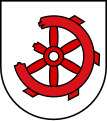Straightening wheel
The straightening wheel is a common figure in heraldry .
It was used as a torture tool for so-called "wheel breaking". The agonizing death penalty was carried out in two stages. First the bones were broken by being rolled over. This was done by a wagon wheel, which was equipped with many triangular blocks. Instead of the pieces of wood, up to 16 knives were often attached to the outer rim. If the offender was still alive, he was tied to the wheel and put on a stake. Then it was stretched. The judging wheel was used for murderers and robbers. The execution always took place on the gallows square with the participation of the people. The executioner himself was not only the executioner , but also the knacker .
Judging wheel and sword are the attributes of the martyr St. Catherine . She is said to have been the first victim. In 307 she was wheeled and then beheaded . The Roman emperor Maxentius is said to have given the instruction.
In the church of Tarnow near Bützow there is a ceiling painting in a vaulted cap with the depiction of the martyrdom of St. Catherine . Here a crowned virgin is executed kneeling with a sword. Another picture in another vaulted cap shows St. Lawrence being roasted on a wire rack. Since then, the wheel and sword have become the executioner's tools and symbols of special jurisdiction.
Cities and municipalities with the power of this jurisdiction have put wheel and sword in their arms. The sword and straightening wheel not only symbolize the attributes of St. Catherine. Example: Until 1738, Katharina was the church and local patroness of Densborn for centuries . As a reference to this history of the Densborn church, which was elevated to a parish church as early as 1289, the attribute of Katharina, the judging wheel, but also the patronage of the parish church is used. Mary Magdalene has now taken her place.
presentation
The straightening wheel is stylized in the coat of arms. Straight or short curved pieces are evenly distributed around the circumference. The wheel hub is a hole. It can be shown in whole or in half, but also with only broken pieces of the wheel in the coat of arms. The coloring or tinging is done according to the heraldic rules.
Many churches, monasteries and places that have a name reference to Saint Catherine have the judging wheel in their coat of arms. The sword is often used, but not mandatory.
So the coat of arms of Sankt Katharinen : split and divided in front; in front above in silver a continuous black bar cross , below in red a silver key with Gothic four-pass hatch and beard turned to the left; in the back, in blue, half a golden straightening wheel, broken along the split, with eight spokes of the whole wheel, covered by a fallen silver sword with a hilt in two rows of silver and red.
Further coats of arms are in the "Open coat of arms of the Bockstaller family" as well
Coat of arms of Sankt Katharinen
Braided on the bike in the coat of arms of Molsheim
Coat of arms of those von Wedel with a black straightening wheel
Coat of arms of Gütenbach with the Katharina wheel
Coat of arms of Stuttgart-Vaihingen with the Katharina wheel
Coat of arms of Hora Svaté Kateřiny (Sankt Katharinaberg) in Bohemia
City coat of arms of Altena with St. Catherine and her attributes sword, wheel and crown
Mindelaltheim coat of arms with half Katharinenrad
Worth seeing
Straightening wheels still preserved are in
- Museum Heimathaus in Scheibbs
- Executioner's Museum in Bernau near Berlin
- Mühlviertel Castle Museum in Freistadt
to see.
Web links
Remarks
- ^ Georg Christian Friedrich Lisch : The Church of Tarnow. In: Yearbooks of the Association for Mecklenburg History and Archeology. Vol. 27, 1862, ISSN 0259-7772 , pp. 212-214.








